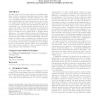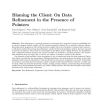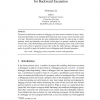180 search results - page 25 / 36 » Locating causes of program failures |
SP
2007
IEEE
14 years 1 months ago
2007
IEEE
We present a new technique that enables software recovery in legacy applications by retrofitting exception-handling capabilities, error virtualization using rescue points. We int...
CAV
2006
Springer
13 years 11 months ago
2006
Springer
Many multithreaded programs employ concurrent data types to safely share data among threads. However, highly-concurrent algorithms for even seemingly simple data types are difficul...
ISSTA
2010
ACM
13 years 11 months ago
2010
ACM
Recently, there has been much interest in developing analyzes to detect concurrency bugs that arise because of data races, atomicity violations, execution omission, etc. However, ...
FAC
2010
13 years 5 months ago
2010
Data refinement is a common approach to reasoning about programs, based on establishing that te program indeed satisfies all the required properties imposed by an intended abstract...
ENTCS
2007
13 years 7 months ago
2007
The need for backward execution in debuggers has been raised a number of times. Backward execution helps a user naturally think backwards and, in turn, easily locate the cause of ...



